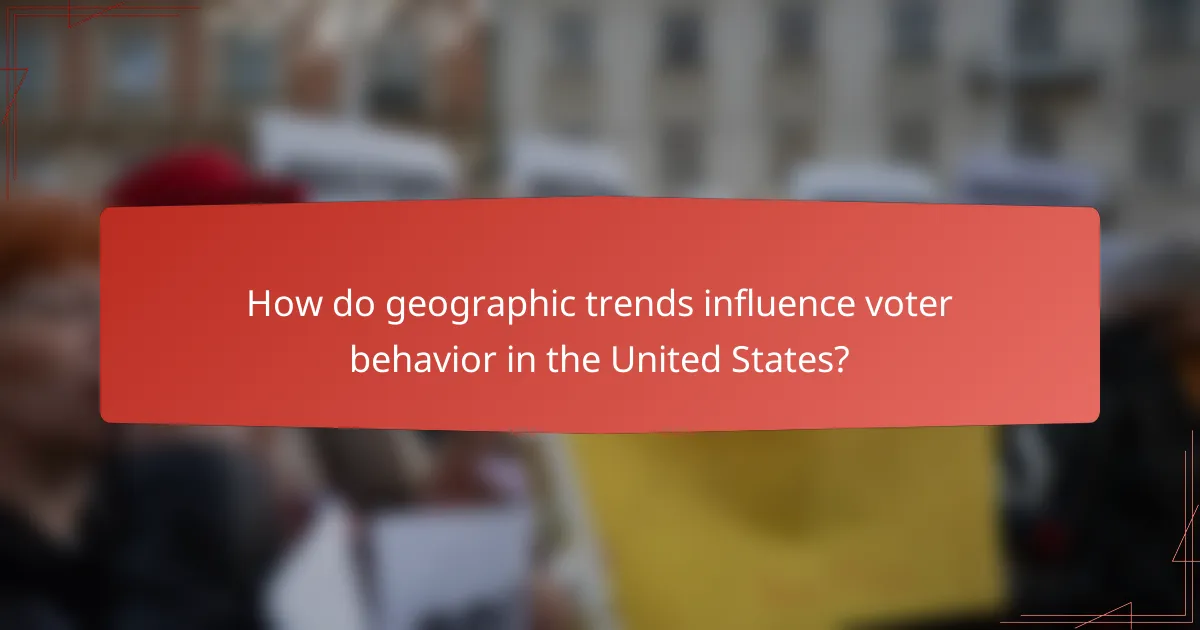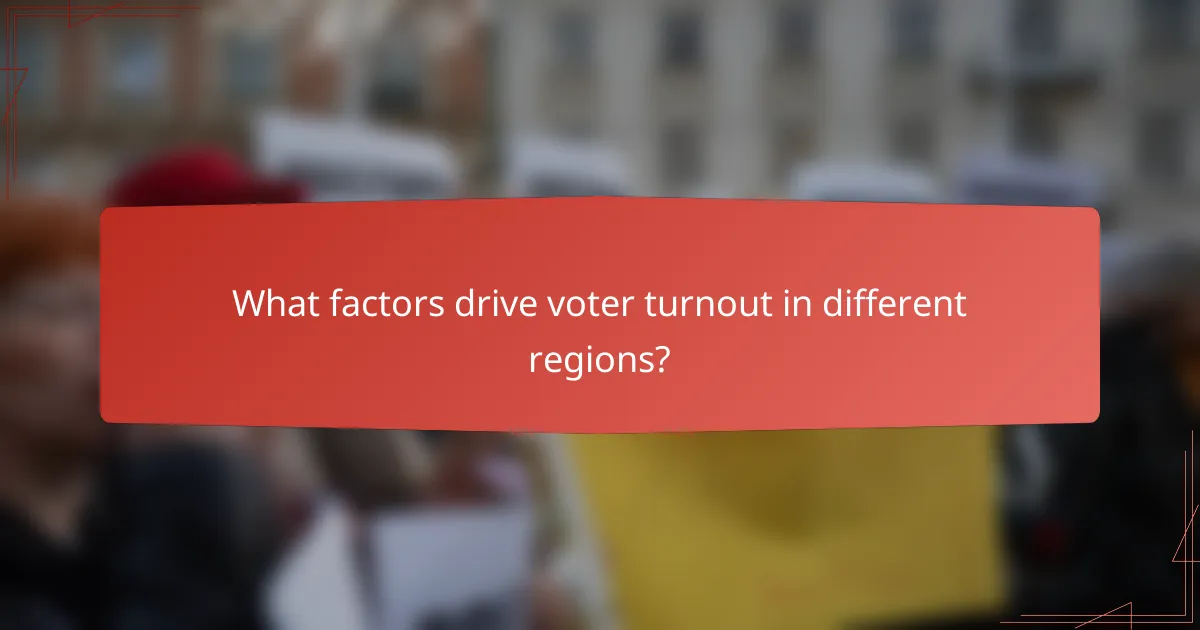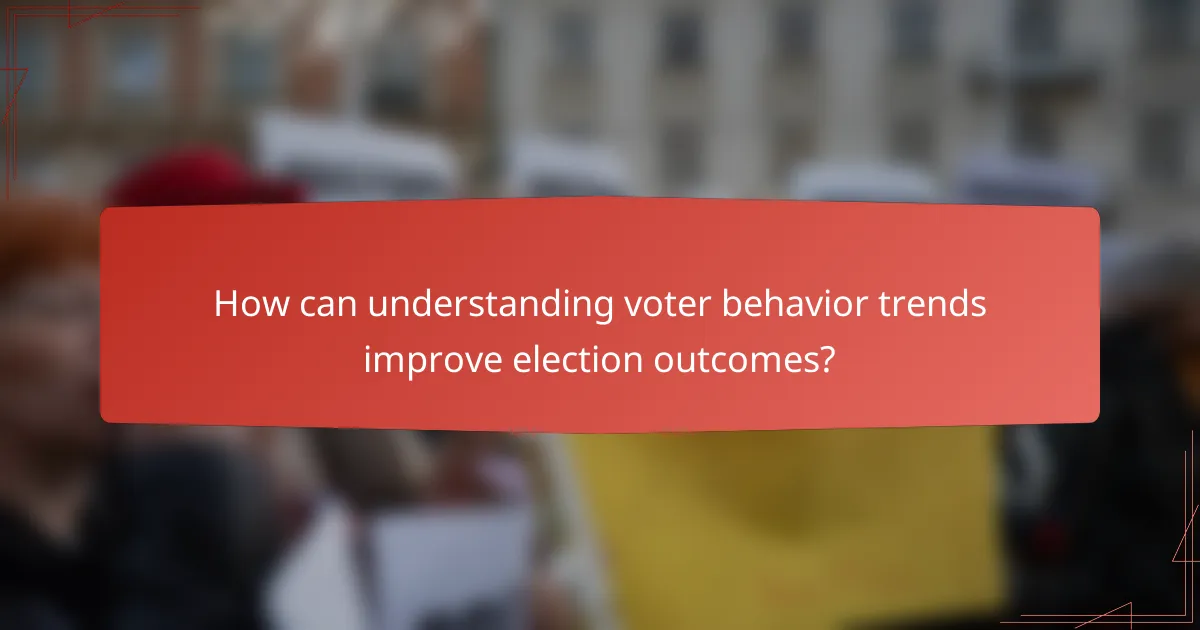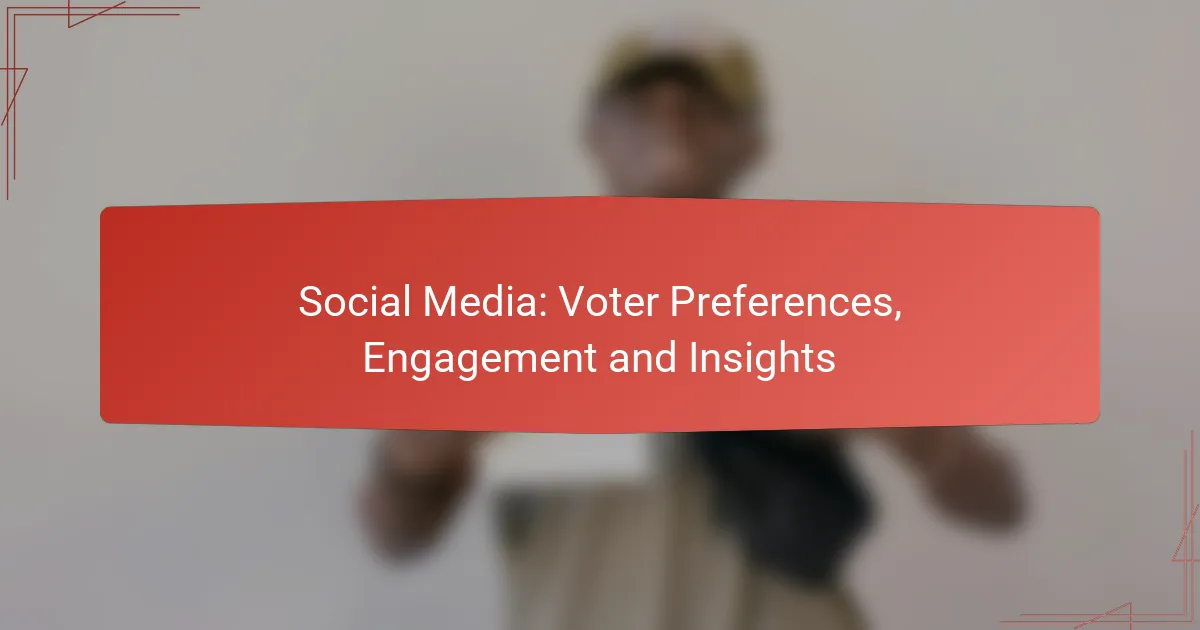Geographic trends play a pivotal role in shaping voter behavior in the United States, influencing how various regions and demographics participate in elections. Factors such as regional voting patterns, demographic changes, and urbanization are critical in determining electoral outcomes, while voter turnout is affected by socioeconomic status, education levels, and access to polling places. Political campaigns increasingly adapt their strategies to align with the unique preferences and concerns of different areas, utilizing local demographics and historical voting patterns to enhance their outreach efforts.

How do geographic trends influence voter behavior in the United States?
Geographic trends significantly shape voter behavior in the United States, affecting how different regions and demographics engage in elections. Factors such as regional voting patterns, demographic shifts, and urbanization play crucial roles in determining electoral outcomes.
Regional voting patterns
Regional voting patterns in the U.S. often reflect historical, cultural, and economic differences. For instance, the Northeast typically leans Democratic, while the South has shown stronger support for Republican candidates. These patterns can shift over time due to changing political landscapes and local issues.
Key factors influencing regional voting include local economies, education levels, and social issues. Understanding these patterns can help political campaigns tailor their messages to resonate with specific voter bases in different areas.
Demographic shifts
Demographic shifts, such as changes in age, race, and education levels, significantly impact voter behavior. For example, younger voters tend to favor progressive policies, while older populations may prioritize stability and traditional values. As demographics evolve, so do the priorities and voting habits of these groups.
Regions experiencing rapid demographic changes, such as urban areas with increasing diversity, may see shifts in voting patterns. Campaigns must adapt to these changes by addressing the unique concerns of emerging voter segments to remain competitive.
Impact of urbanization
Urbanization influences voter behavior by creating distinct political environments. Cities often have higher population densities, leading to diverse viewpoints and progressive policies, while rural areas may prioritize conservative values and local issues. This urban-rural divide can significantly affect election outcomes.
As more people move to urban areas, political campaigns must focus on issues relevant to city dwellers, such as housing, transportation, and public services. Recognizing the impact of urbanization allows candidates to engage effectively with voters in these densely populated regions.

What factors drive voter turnout in different regions?
Voter turnout is influenced by a variety of factors that vary significantly across different regions. Key elements include socioeconomic status, education levels, and access to polling places, all of which can affect citizens’ likelihood to participate in elections.
Socioeconomic status
Socioeconomic status plays a crucial role in voter turnout, as individuals with higher income and wealth levels tend to vote more frequently. This is often due to greater access to resources, including time off work and transportation, which facilitate participation in elections.
In contrast, those from lower socioeconomic backgrounds may face barriers such as financial constraints or lack of flexible work hours, which can hinder their ability to vote. Regions with higher income inequality often see lower turnout rates among disadvantaged groups.
Education levels
Education levels significantly impact voter behavior, with more educated individuals typically showing higher turnout rates. Higher education often correlates with increased political awareness and engagement, leading to a greater likelihood of participating in elections.
Conversely, areas with lower educational attainment may experience lower voter turnout due to a lack of understanding of the electoral process or the importance of voting. Initiatives that promote civic education can help bridge this gap and encourage participation.
Access to polling places
Access to polling places is a critical factor affecting voter turnout, as convenient locations can significantly increase participation rates. Regions with well-distributed polling stations tend to see higher turnout, as voters can easily reach their designated locations.
In contrast, areas with limited access, such as rural regions or those with fewer public transportation options, may struggle with lower turnout. To improve access, local governments can consider extending polling hours, providing transportation services, or implementing mail-in voting options.

How do political campaigns adapt to geographic voter behavior?
Political campaigns adapt to geographic voter behavior by tailoring their strategies to meet the unique preferences and concerns of different regions. This involves analyzing local demographics, cultural values, and historical voting patterns to create effective outreach efforts.
Targeted messaging strategies
Targeted messaging strategies focus on crafting campaign messages that resonate with specific voter demographics in a region. For instance, a campaign may emphasize economic issues in areas with high unemployment, while highlighting education in regions with a younger population. Utilizing data analytics can help identify key issues that matter most to voters in each geographic area.
Campaigns often segment their audience based on factors like age, income, and education level to ensure that their messaging is relevant and impactful. This approach increases the likelihood of voter engagement and support.
Regional campaign events
Regional campaign events are crucial for connecting with voters on a personal level. These events can range from town hall meetings to rallies and are designed to address local issues directly. Hosting events in community centers or popular local venues allows campaigns to draw in larger crowds and foster a sense of community involvement.
Timing is also important; scheduling events around local festivals or significant dates can enhance turnout and engagement. Campaigns should consider the local calendar to maximize participation and visibility.
Use of local influencers
Using local influencers can significantly enhance a campaign’s credibility and reach. Influencers, such as community leaders, local celebrities, or respected figures, can help amplify campaign messages and engage voters who may be skeptical of traditional political outreach. Collaborating with these individuals allows campaigns to tap into established trust and networks within the community.
Campaigns should identify and approach influencers whose values align with their message. This can involve co-hosting events, creating joint social media content, or featuring influencers in campaign advertisements to create a more relatable and authentic connection with voters.

What role does technology play in analyzing voter behavior?
Technology significantly enhances the analysis of voter behavior by providing tools and methodologies that allow for the collection, processing, and interpretation of data. These technological advancements enable political analysts to identify patterns, trends, and correlations that inform campaign strategies and voter outreach efforts.
Data analytics tools
Data analytics tools are essential for dissecting large sets of voter information, helping to uncover insights about preferences and behaviors. These tools can analyze demographic data, voting history, and survey results to predict future voting patterns. For effective analysis, consider using platforms like Tableau or Google Analytics, which can visualize data trends and support decision-making.
When employing data analytics, ensure that the data is clean and relevant. Common pitfalls include relying on outdated information or failing to segment data effectively, which can lead to misleading conclusions. Regularly updating your datasets and using A/B testing can improve the accuracy of your insights.
Geographic Information Systems (GIS)
Geographic Information Systems (GIS) are powerful tools that map voter behavior geographically, revealing how location influences voting patterns. By layering demographic data with geographic information, analysts can identify key areas for voter outreach and understand regional differences in political preferences. For instance, GIS can show how urban and rural voters may have differing priorities based on their locations.
Utilizing GIS effectively requires a clear understanding of the geographic areas being analyzed. Analysts should focus on local issues that resonate with specific communities, as this can enhance voter engagement. Additionally, integrating GIS with other data sources can provide a more comprehensive view of voter behavior.
Social media monitoring
Social media monitoring plays a crucial role in analyzing voter sentiment and engagement in real-time. By tracking conversations and trends on platforms like Twitter and Facebook, analysts can gauge public opinion and identify key issues that resonate with voters. Tools such as Hootsuite or Brandwatch can facilitate this monitoring, allowing for timely responses to voter concerns.
To maximize the effectiveness of social media monitoring, focus on specific keywords and hashtags relevant to your campaign. Regularly analyze engagement metrics to understand what content resonates most with your audience. Avoid overreacting to isolated negative comments; instead, look for broader trends that can inform your strategy.

How can understanding voter behavior trends improve election outcomes?
Understanding voter behavior trends can significantly enhance election outcomes by enabling candidates and parties to tailor their strategies effectively. By analyzing these trends, stakeholders can identify key issues, optimize outreach efforts, and engage voters more meaningfully.
Enhanced voter engagement
Enhanced voter engagement occurs when campaigns leverage insights from voter behavior trends to connect with constituents. For example, using data analytics, campaigns can identify which demographics are more likely to vote and what issues resonate with them, allowing for targeted messaging.
Additionally, utilizing social media platforms and community events can foster a sense of involvement among voters. Engaging voters through personalized communication, such as emails or text messages, can increase turnout by making individuals feel valued and heard.
Informed policy decisions
Informed policy decisions stem from a deep understanding of voter preferences and concerns. By analyzing trends, policymakers can prioritize issues that matter most to their constituents, leading to more effective governance. For instance, if data reveals a growing concern about healthcare, candidates can focus their platforms on healthcare reform.
Moreover, regular feedback mechanisms, such as surveys or town hall meetings, can help gauge public sentiment on various policies. This ongoing dialogue ensures that decisions reflect the electorate’s needs, ultimately fostering trust and support for elected officials.



